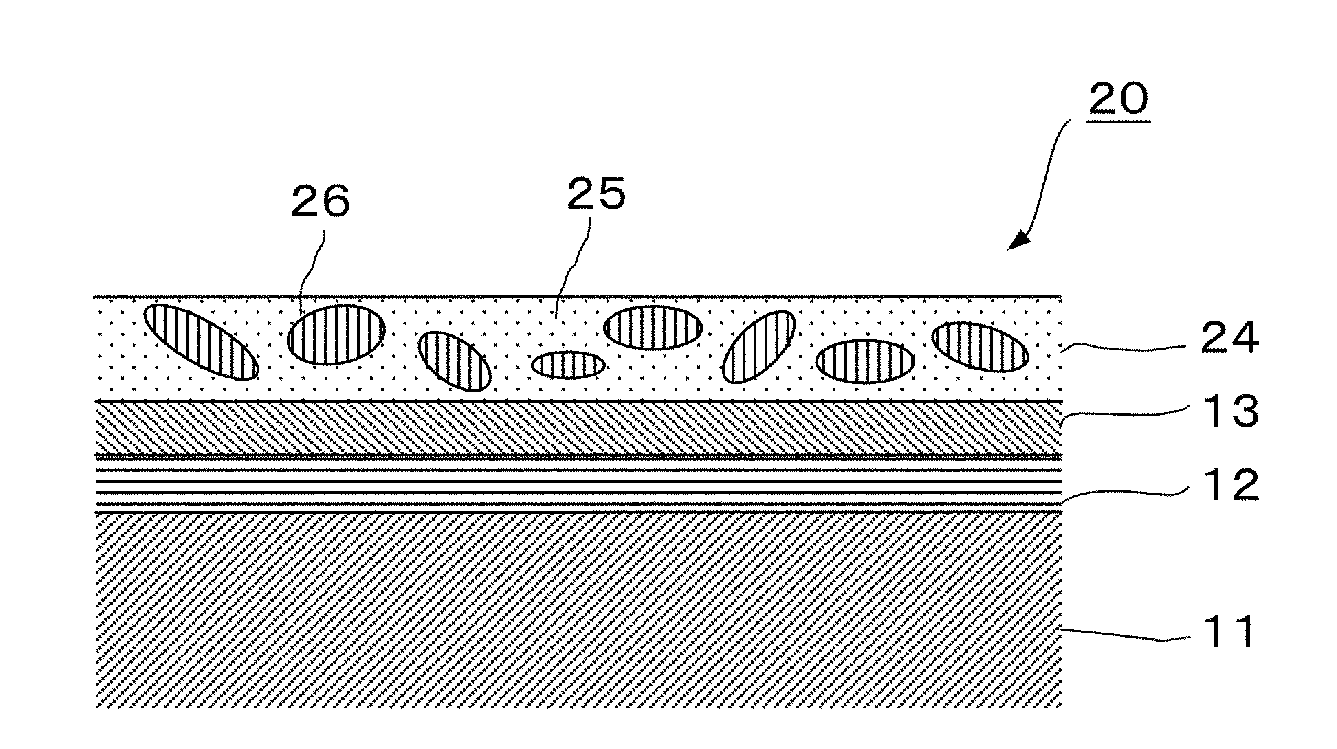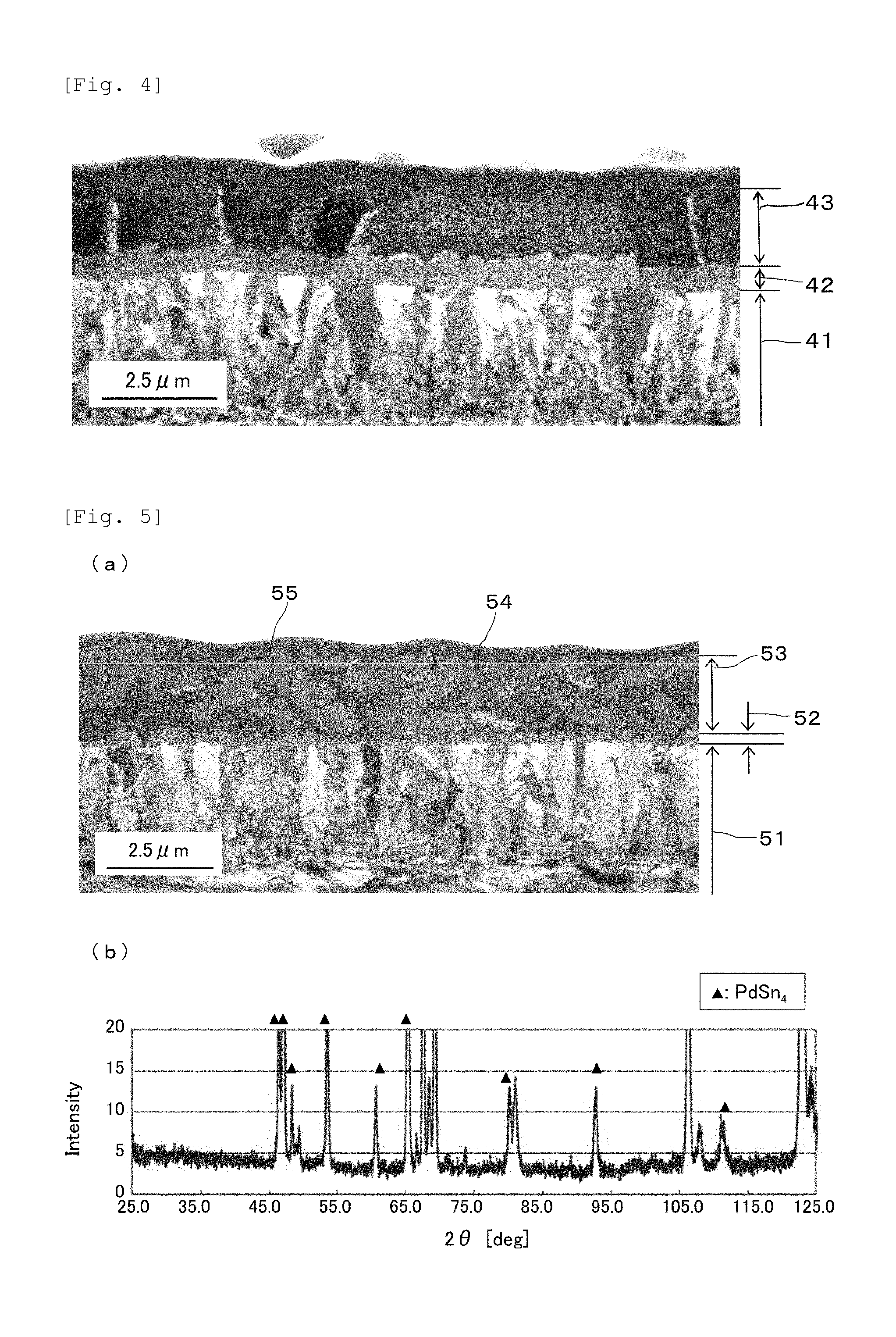Electrical component and method for manufacturing electrical components
a technology of electrical components and components, applied in the direction of superimposed coating process, semiconductor/solid-state device details, transportation and packaging, etc., can solve the problems of short circuit, marked variation in the quality of the resulting electrical component, and the reduction of the solderability of the tin-plated film by heating
- Summary
- Abstract
- Description
- Claims
- Application Information
AI Technical Summary
Benefits of technology
Problems solved by technology
Method used
Image
Examples
example 1
[0060]As a substrate, a phosphor bronze tape was used, in which a number of parts to be contacts for a connector are connected via a connecting member. This phosphor bronze tape was degreased and washed with an acid followed by copper strike plating (plating thickness: 0.1 μm) and then nickel plating (plating thickness: 2.0 μm) to form a base plated layer with a total thickness of about 2 μm, which was plated with palladium to give a middle plated layer with a thickness of 0.05 μm. The resulting middle plated layer was plated with tin to 3 μm to give a surface plated layer with a thickness of about 3 μm. Each of these plating processes was conducted by hoop plating, in which a palladium plating solution was PD-LF-800 from N. E. Chemcat. Corporation and a tin plating solution was SBS-M from Yuken Industry Co., Ltd. Thus, tape 1 having a number of contacts for a connector, as an electrical component of the present invention, connected to the tape was obtained. That is, tape 1 has the ...
example 2
[0062]Tape 1 produced in Example 1 was placed in a simple reflow oven and annealed at a peak temperature of 225° C. for 2 min to give tape 2. The cross-section of tape 2 thus produced was observed as described in Example 1. FIG. 4 shows a microgram of the cross-section of the observed part. In FIGS. 4, 41, 42 and 43 indicate a nickel base layer, a diffusion layer as a middle layer and a tin surface layer, respectively.
example 3
[0063]Tape 1 produced in Example 1 was placed in a portable reflow oven and reflowed at a peak temperature of 310° C. for 2 sec to give tape 3. The cross-section of tape 3 thus produced was observed as described in Example 1. FIG. 5(a) shows a microgram of the cross-section of the observed part. In FIGS. 5(a), 51, 52 and 53 indicate a nickel base layer, a tin-palladium diffusion layer as a middle layer and a surface layer, respectively. In the surface layer 53, 54 is a tin phase and 55 is a tin-palladium alloy phase. Furthermore, the surface of tape 3 was observed by an X-ray diffractometer. FIG. 5(b) shows the X-ray diffraction pattern obtained. Thus, the presence of a peak corresponding to PdSn4 was confirmed.
[0064]In Example 2, it was demonstrated that annealing after forming each plated layer allowed for forming the diffusion layer 42 between the surface layer43 and the base layer 41. In Example 2, it was also demonstrated that the diffusion layer 42 was formed under the tin sur...
PUM
| Property | Measurement | Unit |
|---|---|---|
| Thickness | aaaaa | aaaaa |
| Angle | aaaaa | aaaaa |
| Molar density | aaaaa | aaaaa |
Abstract
Description
Claims
Application Information
 Login to View More
Login to View More - R&D
- Intellectual Property
- Life Sciences
- Materials
- Tech Scout
- Unparalleled Data Quality
- Higher Quality Content
- 60% Fewer Hallucinations
Browse by: Latest US Patents, China's latest patents, Technical Efficacy Thesaurus, Application Domain, Technology Topic, Popular Technical Reports.
© 2025 PatSnap. All rights reserved.Legal|Privacy policy|Modern Slavery Act Transparency Statement|Sitemap|About US| Contact US: help@patsnap.com



